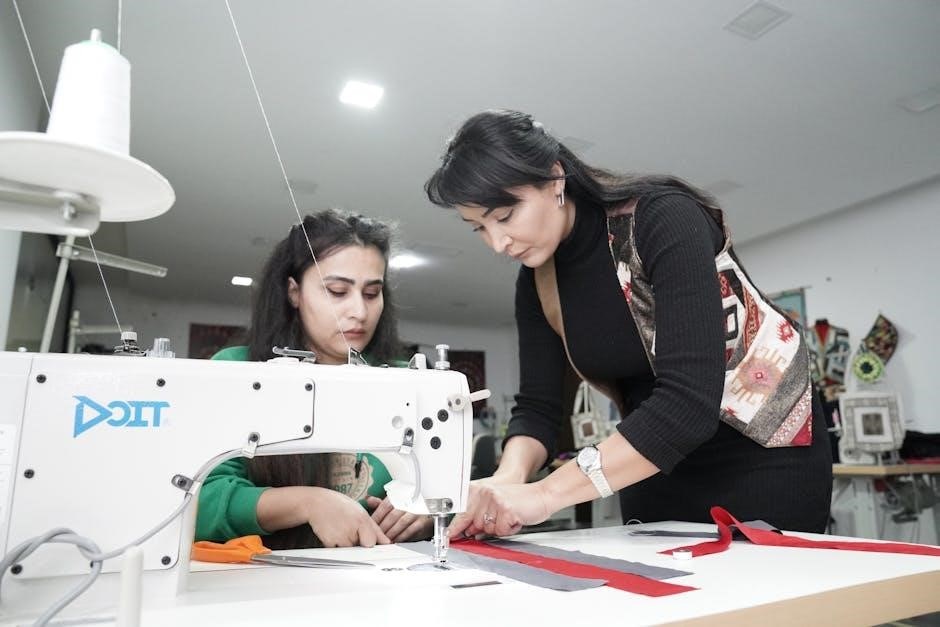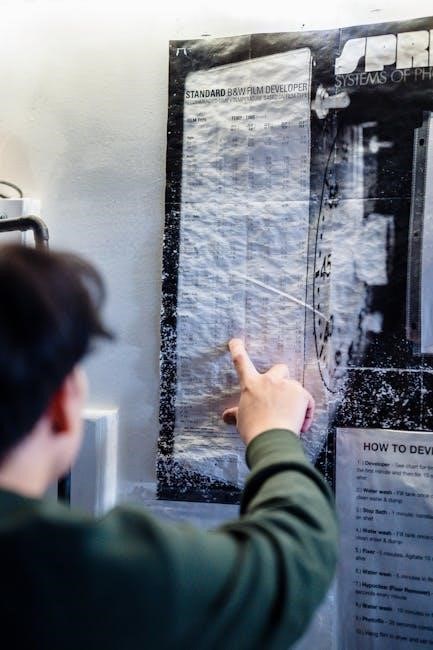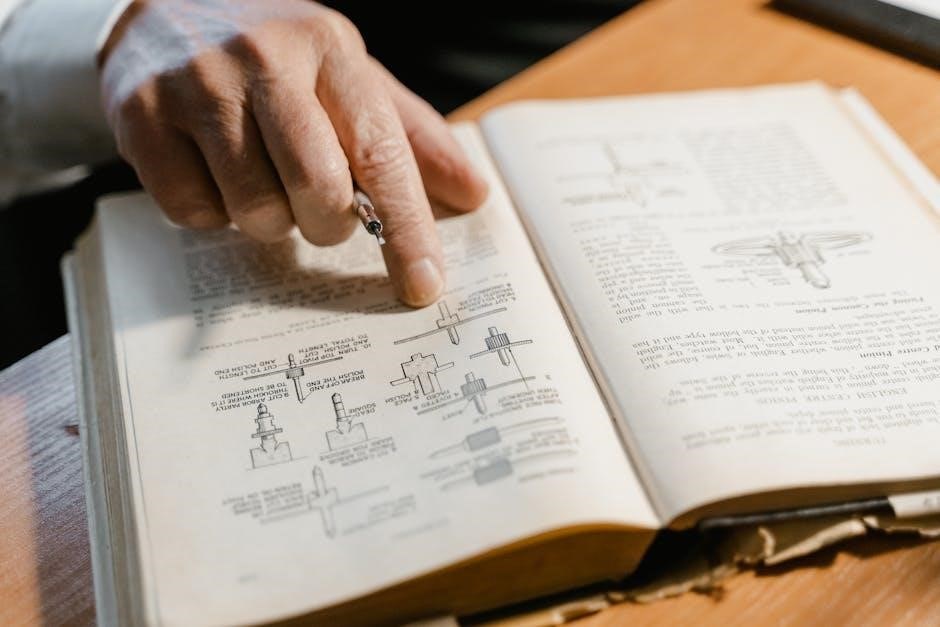
d800 instruction manual
Welcome to the Nikon D800 Instruction Manual. This comprehensive guide covers everything from basic operations to advanced features, ensuring you master your camera’s full potential and troubleshoot effectively.
Overview of the Nikon D800 and D800E Cameras
The Nikon D800 and D800E are high-resolution DSLR cameras designed for professional photographers and enthusiasts. Both models feature a 36.3MP full-frame sensor, delivering exceptional detail and clarity. The D800E variant excludes the optical low-pass filter, enhancing sharpness for specialized applications. These cameras are built for durability with magnesium alloy frames and weather-sealed bodies. They offer advanced autofocus, 1080p video recording, and extensive customization options. Ideal for studio, landscape, and portrait photography, the D800 series is a powerful tool for capturing high-quality images. The manual provides detailed guidance to help users unlock their full potential and make informed creative decisions.
Importance of Reading the Instruction Manual
Reading the Nikon D800 instruction manual is essential for understanding the camera’s advanced features and optimizing its performance. The manual provides detailed insights into setting up, operating, and troubleshooting the camera, ensuring you make the most of its capabilities. It covers key functions like autofocus, metering, and video recording, as well as customization options. By familiarizing yourself with the manual, you can avoid common issues, improve image quality, and unlock the camera’s full potential. Additionally, it helps you stay updated with firmware updates and maintenance tips, ensuring your D800 remains in top condition for years of professional-grade photography.
Key Features and Capabilities of the D800
The Nikon D800 is a powerful DSLR camera featuring a 36.3MP full-frame CMOS sensor, delivering exceptional image quality with high resolution and low noise. It offers a 51-point autofocus system for precise subject tracking and a 3.2-inch, 921k-dot LCD screen for clear image preview and menu navigation. The camera supports 1080p HD video recording, HDR, and interval shooting, making it versatile for both stills and video. With weather-sealed construction, it withstands harsh conditions, while its advanced metering and white balance systems ensure accurate exposures. Additionally, the D800 supports wireless connectivity and compatibility with Nikon’s range of lenses and accessories, catering to professionals and enthusiasts alike.

Technical Specifications and Design
The Nikon D800 features a 36.3MP full-frame CMOS sensor, 51-point autofocus, and a 3.2-inch, 921k-dot LCD monitor. Its magnesium alloy body is weather-sealed for durability.
Physical Dimensions and Build Quality
The Nikon D800 boasts a robust magnesium alloy body, ensuring durability and resistance to harsh conditions. Its weather-sealed design protects against dust and moisture, making it ideal for outdoor photography. The camera measures 144.78 x 121.82 x 81.28mm and weighs approximately 900g, balancing portability with professional-grade build quality. The ergonomic grip and intuitive controls enhance handling, while the reinforced chassis supports the high-resolution sensor and advanced features. This sturdy construction ensures long-term reliability, catering to both professional photographers and enthusiasts who demand exceptional performance and reliability in various shooting environments.
Image Sensor and Processor Details
The Nikon D800 features a 36.3-megapixel full-frame CMOS sensor, delivering exceptional image quality with precise detail and rich tonal range. Paired with the EXPEED 3 image processor, it ensures fast performance, efficient noise reduction, and enhanced color accuracy. The sensor’s wide dynamic range captures subtle shadows and highlights, while the processor supports advanced features like HDR and multiple exposure. The combination enables rapid data processing, allowing for continuous shooting at up to 4 frames per second in FX format. This powerful duo ensures photographers achieve professional-grade results with minimal noise, even in low-light conditions, making it ideal for both stills and video recording.
Viewfinder and LCD Monitor Specifications
The Nikon D800 features a high-quality optical viewfinder with 100% frame coverage and 0.7x magnification, ensuring precise composition. The 3.2-inch LCD monitor boasts a 921,000-dot resolution, providing crisp and detailed previews. The monitor supports wide viewing angles and is protected by scratch-resistant glass. The viewfinder includes an eyepoint of 17mm, accommodating eyeglass wearers. The LCD also offers a convenient live view mode for precise focus control. These features combine to enhance both shooting accuracy and playback clarity, making the D800 ideal for professional and enthusiast photographers seeking reliable monitoring and framing tools for their creative work.

Setting Up Your Nikon D800
Unbox and prepare your D800 with care, ensuring all accessories are included. Charge the battery fully, insert memory cards, and update firmware for optimal performance and functionality.
Unboxing and Initial Setup
Welcome to your Nikon D800 unboxing experience! Carefully unpack the camera body, battery, charger, memory cards, and manuals. Ensure all accessories are included and undamaged.
Begin by charging the battery until the charger indicates it’s fully powered. Insert memory cards into the designated slots, ensuring they are compatible and formatted for optimal performance.
Power on the camera and follow the on-screen prompts for initial setup, including language, date, and time settings; Update the firmware to the latest version for enhanced functionality and bug fixes.
Familiarize yourself with the camera’s controls and settings to prepare for your first shoot. Proper setup ensures you’re ready to capture stunning images with your Nikon D800.
Charging the Battery and Inserting Memory Cards
Charge the EN-EL15 battery using the provided MH-25 charger. Plug the charger into a power outlet and ensure the battery is properly seated. The charging indicator will turn off when fully charged, typically taking 2-3 hours.
Insert memory cards into the D800’s dual card slots. Use compatible cards (CF and SD/SDHC/SDXC UHS-I) and ensure they are formatted in the camera. Insert the cards with the label side facing the camera back and gently push until they click into place. Always format cards in the camera to avoid data loss and ensure optimal performance.
Updating Firmware and Installing Software
Regular firmware updates ensure optimal camera performance. Download the latest firmware from Nikon’s official website and follow on-screen instructions. Use a memory card to transfer the update to your D800. Insert the card, go to the camera’s setup menu, and select Firmware Version to initiate the update. Additionally, install Nikon software like NX Studio for enhanced image management. Note that Nikon now requires a Nikon ID to access certain software features. Always use genuine Nikon sources to avoid security risks and ensure compatibility. Keep your camera and software up-to-date for the latest features and improvements.

Understanding Camera Controls
Mastering the Nikon D800’s controls is essential for enhancing your photography experience. This section guides you through understanding and customizing the camera’s intuitive controls for optimal use.
Top Control Dial and Button Layout
The Nikon D800 features an intuitive top control dial and button layout designed for quick access to essential functions. The mode dial on the top left allows you to switch between shooting modes like Program, Shutter Priority, Aperture Priority, and Manual. Adjacent to it, the shutter release button is ergonomically placed for comfortable operation. The top right also houses the ISO button and exposure compensation button, enabling easy adjustments to sensitivity and exposure settings. These controls are strategically positioned to streamline your workflow and enhance creativity during photography sessions.
The layout ensures that frequently used functions are within easy reach, reducing the need to navigate through menus. This design promotes efficiency and allows photographers to focus on capturing moments without interruption.
Rear Control Panel and Multi-Selector
The rear control panel of the Nikon D800 is designed for intuitive operation, featuring a 3.2-inch LCD monitor with 921,000-dot resolution for clear image review. The multi-selector button allows for easy navigation of menus and quick selection of autofocus points. Dedicated buttons provide instant access to essential functions like live view, white balance, and playback. The layout is ergonomic, with controls positioned for comfortable thumb operation during shooting. The multi-selector also enables seamless image browsing and adjustments, making it a key tool for efficient workflow. This design ensures photographers can focus on capturing moments while maintaining full control over camera settings.
Customizing Camera Buttons and Controls
The Nikon D800 allows photographers to customize button functions to suit their workflow. The Fn button and Depth-of-Field Preview button can be reassigned to access frequently used settings like ISO, white balance, or bracketing. Additionally, the multi-selector’s center button can be programmed for tasks like selecting autofocus points or locking exposure. This customization enhances shooting efficiency and reduces distractions. By tailoring controls to personal preferences, users can streamline their process and focus on creativity. The Custom Setting Menu provides detailed options for button assignment, ensuring the camera adapts to individual needs. This feature is a powerful tool for optimizing camera handling and productivity.

Shooting Modes and Settings
The Nikon D800 offers a variety of shooting modes, including Program, Shutter Priority, Aperture Priority, and Manual, providing flexibility for different photography scenarios. Customize settings to refine autofocus, metering, and exposure for precise control over your images.
Program Mode, Shutter Priority, and Aperture Priority
The Nikon D800 offers Program Mode, Shutter Priority, and Aperture Priority for versatile shooting. Program Mode automatically adjusts aperture and shutter speed while allowing customization. Shutter Priority (S) lets you set shutter speed to control motion, with the camera adjusting aperture. Aperture Priority (A) enables manual aperture control for depth of field management. Metering modes like Matrix, Center-Weighted, and Spot ensure accurate exposure. These semi-automatic modes provide flexibility for photographers to balance creativity with technical precision, making them ideal for various lighting conditions and subjects. Custom settings can refine results further, offering a balance between automation and manual control for optimal image capture.
Manual Mode and Bulb Shooting
Manual Mode (M) offers full control over aperture and shutter speed, ideal for creative photography. Bulb Shooting (B) keeps the shutter open as long as the button is pressed, perfect for long exposures like star trails. Access these modes via the Mode Dial. For Bulb Shooting, use a remote or self-timer to prevent shake. This mode is great for artistic effects in low light. With Manual Mode, you can adjust settings to achieve unique results, enhancing your creative control and capturing stunning imagery tailored to your vision.
Autofocus Modes and Metering Options
The Nikon D800 offers advanced autofocus modes, including Single-Servo AF (AF-S) for stationary subjects and Continuous-Servo AF (AF-C) for moving subjects. The camera also features Manual Focus (MF) for precise control; Metering options include 3D Color Matrix Metering II, Center-Weighted Metering, and Spot Metering, ensuring accurate exposure in various lighting conditions. Use the multi-selector to choose AF points or switch metering modes. These features allow photographers to adapt to dynamic scenes, ensuring sharp focus and balanced exposures. Experiment with these settings to optimize your results in both stills and video recording.

Image Quality and Management
The Nikon D800 offers exceptional image quality through customizable Picture Controls, versatile file formats, and precise white balance settings. These tools enable photographers to capture stunning detail and achieve accurate color reproduction, ensuring professional-grade results in every shot.
Picture Controls and Color Profiles
Picture Controls in the Nikon D800 allow photographers to customize image settings for optimal results. These include Standard, Neutral, Vivid, Monochrome, and Portrait options, each offering unique tonal and color adjustments. Additionally, the camera supports custom color profiles, enabling precise control over color accuracy and consistency. By fine-tuning these settings, users can achieve their desired aesthetic, whether for professional shoots or personal projects. The D800 also supports external software like Nikon’s Picture Control Utility for advanced profile customization. These features ensure that every image meets the photographer’s creative vision, making the D800 a powerful tool for both enthusiasts and professionals.
File Formats: JPEG, RAW, and TIFF
The Nikon D800 supports various file formats to cater to different photographic needs. JPEG offers compressed files ideal for sharing, with adjustable quality settings. RAW files store uncompressed data, preserving maximum detail for post-processing. TIFF provides high-quality, uncompressed images without loss, suitable for professional workflows. The D800 allows simultaneous recording of RAW + JPEG, offering flexibility. Understanding these formats helps photographers choose the best option for their workflow, ensuring optimal image quality and efficiency. This section explains how to select and manage these formats, leveraging the D800’s capabilities for stunning results;
White Balance Settings and Fine-Tuning
The Nikon D800 offers precise white balance settings to ensure accurate color representation. Choose from options like Auto, Incandescent, Fluorescent, and manual settings such as Preset and Color Temperature. Fine-tuning allows for adjustments inamber-blue and green-magenta axes, enabling custom color profiles. The camera also supports live view preview of white balance changes, simplifying on-location adjustments. These features are crucial for capturing natural hues in various lighting conditions, whether shooting in RAW or JPEG. By mastering white balance, photographers can enhance image quality and achieve professional-grade results with minimal post-processing.
Advanced Shooting Techniques
Master advanced techniques like multiple exposure, HDR, and interval shooting. Utilize live view for precise framing and explore video recording options for dynamic storytelling and creative expression.
Multiple Exposure and Interval Shooting
The Nikon D800 offers advanced techniques like multiple exposure, allowing you to capture and combine up to three shots in a single frame. This feature is ideal for creative overlays and blending images. Interval shooting enables you to set intervals between shots, perfect for time-lapse photography or capturing dynamic changes over time. Both modes provide precise control, letting you customize settings like exposure adjustment and interval duration. These features empower photographers to explore innovative ways to tell stories and document phenomena, making the D800 a versatile tool for both artistic and technical photography projects.
HDR Photography and Bracketing
HDR (High Dynamic Range) photography captures a wider range of tonal values by combining multiple exposures. The Nikon D800 supports bracketing, allowing you to shoot up to 9 frames at intervals of 1/3, 1/2, or 1 EV. This feature is ideal for scenes with extreme contrasts, such as landscapes or interiors. After shooting, HDR software can merge these images to create a single photo with enhanced detail in both shadows and highlights. Bracketing can also be used for creative effects or to ensure proper exposure when shooting in challenging lighting conditions. The D800’s bracketing function is customizable, giving you control over the number of frames and exposure increments to suit your needs. For best results, use a tripod to ensure alignment of the bracketed shots.
Live View and Video Recording Basics
The Nikon D800 offers Live View, enabling precise focus control and framing on the 3.2-inch LCD monitor. For video recording, the D800 supports full HD (1080p) at 24, 25, or 30 fps, and 720p at 60 fps. Videos are saved in MOV format with H.264 compression. To start recording, switch to Live View mode and press the record button. The camera also allows manual focus adjustment and external microphone input for improved audio quality. Additionally, you can capture still images during video recording. Settings like aperture, shutter speed, and ISO can be adjusted before or during recording for creative control. Use the built-in microphone or connect an external one for better sound quality. The D800’s video capabilities make it versatile for both stills and motion capture.

Connectivity and Wireless Features
The Nikon D800 supports wireless connectivity for image transfer and remote control via Camera Control Pro 2. It enables network connections and FTP server transfers, enhancing workflow efficiency and allowing seamless integration with compatible devices and software for professional photography needs.
Wi-Fi and Wireless Transmitter Setup
Setting up Wi-Fi and wireless connectivity on the Nikon D800 involves installing the Wireless Transmitter Utility and connecting the optional WT-4 transmitter. This allows photographers to transfer images to a computer or FTP server wirelessly. The camera supports network connections, enabling remote control via Camera Control Pro 2. Ensure the transmitter is properly attached to the camera’s USB port and configured using the provided software. Network settings, such as SSID and passwords, must be entered accurately for a stable connection. This feature enhances workflow efficiency, especially in professional environments, by streamlining image transfer and remote shooting operations.
Remote Camera Control with Camera Control Pro 2
Camera Control Pro 2 enables remote control of the Nikon D800, allowing photographers to adjust settings, capture images, and transfer files wirelessly. Using this software, users can operate the camera from a computer, access live view, and control focusing, exposure, and other parameters. It supports efficient image transfer to a computer or FTP server, enhancing workflow in professional environments. The software is compatible with the WT-4 wireless transmitter, providing seamless connectivity for remote shooting operations. This feature is particularly useful for studio, landscape, and wildlife photography, offering greater convenience and control over camera functions during shoots.
Transferring Images to a Computer or FTP Server
The Nikon D800 allows seamless image transfer to a computer or FTP server, enhancing workflow efficiency. Using the WT-4 wireless transmitter or a USB cable, photographers can directly transfer images to a computer. The Camera Control Pro 2 software enables wireless transfers and remote camera control. Images can also be uploaded to an FTP server for instant sharing or backup. Additionally, the Nikon Imaging Cloud service supports importing image editing settings, streamlining post-processing. This feature is ideal for professionals needing to organize and share photos efficiently. The manual provides detailed steps for setting up and using these transfer methods effectively.

Maintenance and Troubleshooting
Regularly clean the image sensor and mirror to prevent dust spots. Update firmware for bug fixes and performance improvements. Troubleshoot common issues like error messages or connectivity problems.
Cleaning the Image Sensor and Mirror
Cleaning the image sensor and mirror is essential for maintaining image quality. Use the camera’s built-in cleaning mode by enabling “Lock Mirror Up” in the setup menu. Ensure the battery is fully charged or use an AC adapter to prevent interruptions. Gently brush the sensor with a soft, dry brush designed for cameras. Avoid touching the sensor surface. For stubborn spots, use a cleaning swab with a small amount of ethanol, but only as a last resort. Regular cleaning prevents dust from affecting your photos. Always refer to the manual for detailed steps to avoid damaging your camera’s internal components.
Updating Firmware and Software
To update the firmware on your Nikon D800, start by checking Nikon’s official website for the latest firmware version. Download the firmware file, typically in .bin format, and transfer it to a memory card. Insert the card into the camera, navigate to the setup menu, and select the firmware update option. Ensure the battery is fully charged or use an AC adapter to prevent interruptions. Follow on-screen instructions carefully, avoiding any interruptions during the update process. After completion, the camera may reboot. Verify the firmware version in the menu to confirm success. Additionally, update Nikon software on your computer, such as Transfer, ViewNX, or Capture NX-D, by downloading the latest versions from Nikon’s website and following installation instructions. Regular updates ensure optimal performance, compatibility, and access to new features.
Common Issues and Diagnostic Techniques
Common issues with the Nikon D800 include light leaks, image sensor spots, and error messages during operation. To diagnose these, inspect the camera body for any gaps or worn seals that may cause light leaks. For sensor spots, use manual cleaning with a swab and cleaning solution. Error messages often indicate firmware or hardware issues; check the battery level and ensure it’s fully charged. Resetting the camera to default settings can resolve unexpected behavior. Regularly update firmware and clean the sensor to prevent issues. If problems persist, consult the troubleshooting section or contact Nikon support for professional assistance.

Accessories and Compatibility
The Nikon D800 supports a range of accessories, including high-quality lenses, external flashes, battery grips, remote controls, and protective cases. These enhance functionality and customization, ensuring compatibility with Nikon’s ecosystem for optimal performance and image capture.
Recommended Lenses for the D800
The Nikon D800 is compatible with a wide range of AF-S Nikkor lenses, offering exceptional image quality. Top recommendations include the AF-S Nikkor 14-24mm f/2.8G ED for wide-angle shots, the AF-S Nikkor 24-70mm f/2.8G ED for versatility, and the AF-S Nikkor 70-200mm f/2.8G ED VR II for telephoto needs. Prime lenses like the AF-S Nikkor 85mm f/1.4G and AF-S Nikkor 50mm f/1.4G are ideal for portraits. Additionally, third-party lenses from Tamron and Sigma offer affordable alternatives without compromising quality. Using genuine Nikon lenses ensures optimal performance, leveraging the D800’s 36.3MP sensor for stunning results in various photography genres, from landscapes to portraits and action shots.
External Flash and Speedlight Compatibility
The Nikon D800 is fully compatible with a variety of external flashes and Speedlights, enhancing your lighting control for professional results. The SB-910 and SB-700 Speedlights are highly recommended for their advanced i-TTL metering and wireless operation. The SB-400 is a more compact option for casual use. These units integrate seamlessly with the D800’s flash system, offering features like slow sync, rear-curtain sync, and high-speed sync. Additionally, third-party flashes from brands like Yongnuo are compatible, though they may lack some advanced features. Using an external Speedlight significantly improves lighting versatility, enabling better control over shadows, highlights, and creative effects in your photography.
Other Accessories: Grips, Remotes, and Cases
The Nikon D800 can be enhanced with a range of accessories to improve functionality and protection. The MB-D12 Multi-Power Battery Grip extends shooting capacity and provides a vertical shutter release for easier handling. Wireless remotes like the MC-36A or third-party options enable remote shutter release, reducing camera shake. For protection, Nikon offers the CF-80 semi-soft case, while leather cases provide a stylish and durable option. These accessories not only enhance the camera’s usability but also ensure it remains in optimal condition, making them essential for professionals and enthusiasts alike seeking to maximize their D800’s potential and longevity.

Resources and Support
Access the official Nikon D800 user manual in PDF format on Nikon’s website. Explore customer support options, service centers, and online forums for troubleshooting and expert advice.
Downloading the Official User Manual in PDF
To download the official Nikon D800 user manual in PDF format, visit Nikon’s official website. Navigate to the support section, select your camera model, and choose the PDF manual. The manual covers all features, settings, and troubleshooting tips. Supplementary guides, such as technical notes and picture control editions, are also available. Ensure you have a reliable internet connection and sufficient storage space. The PDF manual is a valuable resource for mastering your camera’s capabilities and resolving any operational issues. Download directly from Nikon’s trusted sources to avoid unauthorized versions.
Nikon Customer Support and Service Centers
Nikon offers comprehensive customer support through various channels. Visit their official website to access live chat, email assistance, and phone support. For repairs, locate authorized service centers near you. These centers provide professional maintenance and warranty services. Additionally, Nikon hosts online resources, including FAQs and troubleshooting guides, to help users resolve common issues independently. Registered users can also benefit from exclusive support features. Ensure to use only Nikon-authorized service centers to maintain your camera’s warranty and quality standards. Their dedicated team is ready to assist with any inquiries or concerns about your D800 camera.
Online Communities and Forums for D800 Users
Engage with fellow Nikon D800 users through online forums and communities. Platforms like Nikon’s official forums, social media groups, and photography websites offer valuable discussions. Share tips, ask questions, and learn from experienced photographers. These communities are ideal for troubleshooting, discovering new techniques, and staying updated on firmware updates. Many forums also host tutorials, workshops, and contests to enhance your photography skills. Additionally, websites like Nikon Imaging Cloud provide resources for image editing and sharing. Join these communities to connect with like-minded enthusiasts and maximize your D800’s potential.